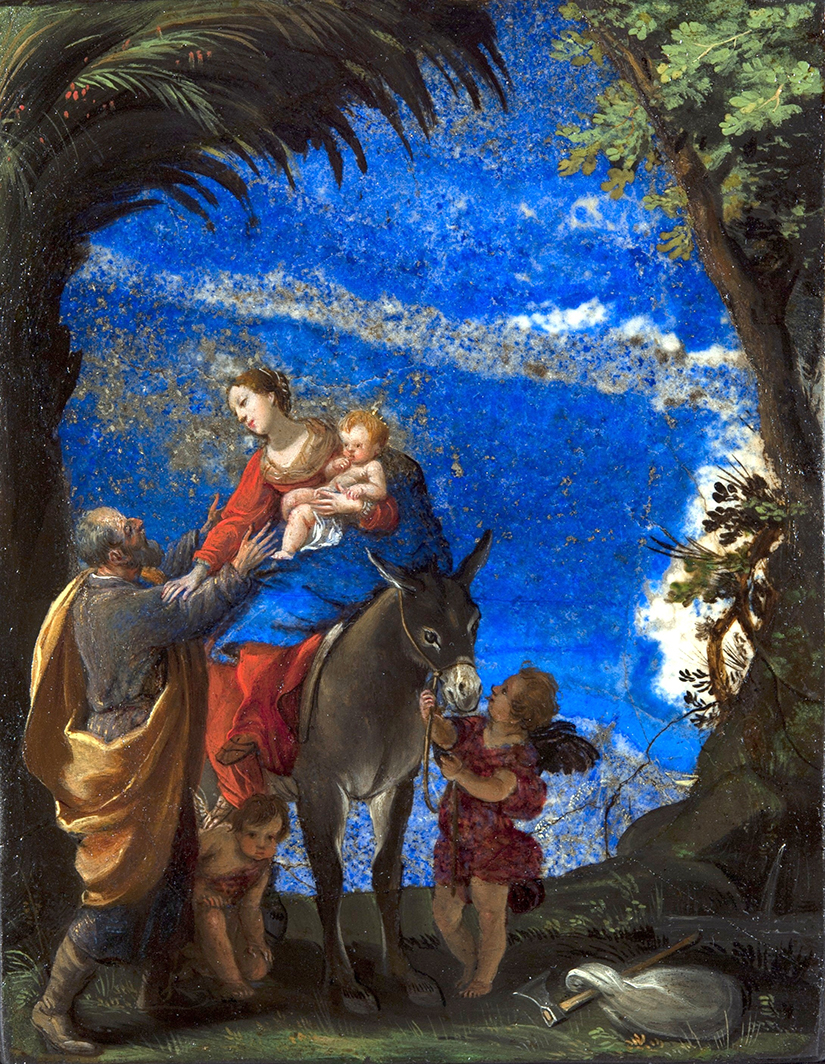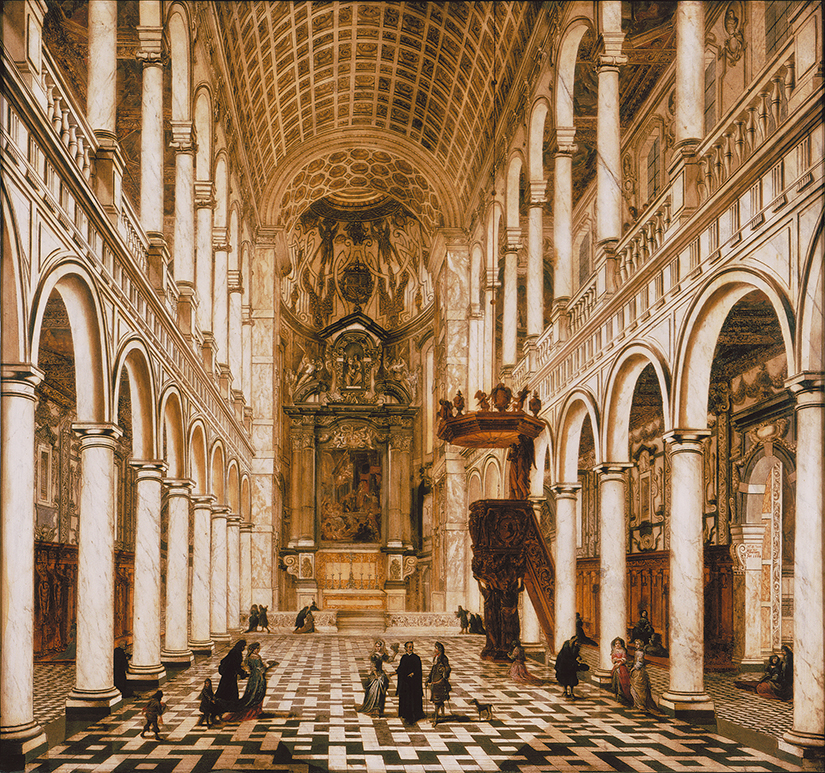 Jacques Stella, French, 1596-1657; “Rest on the Flight into Egypt”; oil on lapis; Lukas T. Ruflin, SwitzerlandHumans have been painting on stone since the days of prehistoric cave dwelling, but a new exhibit at the St. Louis Art Museum explores in new depth the unusual medium used in fine Renaissance art.
Jacques Stella, French, 1596-1657; “Rest on the Flight into Egypt”; oil on lapis; Lukas T. Ruflin, SwitzerlandHumans have been painting on stone since the days of prehistoric cave dwelling, but a new exhibit at the St. Louis Art Museum explores in new depth the unusual medium used in fine Renaissance art.
“Paintings on Stone: Science and the Sacred, 1530-1800” opened Feb. 20 at the St. Louis Art Museum. The exhibit includes more than 70 paintings on a variety of stones, such as slate, marble, limestone and lapis lazuli.
Although artists had experimented with stone for centuries, in the early 16th century, painters like Venetian artist Sebastiano del Piombo developed long-lasting methods for painting oil directly onto stone supports.
“Initially, the reason artists turned to stone wasn’t because of the visual properties — it wasn’t because of the color, the lines and the designs,” exhibit curator Judith Mann said. “It was because stone had meaning.”
The early painters of this period typically covered the entire stone with paint, leaving no bare surface. But by the late 16th and early 17th century, many began to use the natural stone to enhance their paintings. One of the first stone surfaces commonly used by European artists was slate. This dark stone allowed painters to achieve different lighting effects with bright white or gold paint, but the bare stone also enhanced the visual effect of somber scenes like those from the Lord’s Passion.
“Scenes related to the suffering, death and mourning of Jesus that depicted Him recumbant on actual stone directly recalled the slab on which Jesus’ body was prepared for burial and connected to the presence of His body” on the altar during Mass, an exhibit panel explains.
As more varieties and colors of stones became easily available to artists, they found opportunities to use the coloration and patterns of stones to inform the composition of their paintings.
Antonio Tempesta took advantage of the natural pigmentation of brecciated limestone, a piece of sedimentary stone made up of more than one kind of limestone, to create the landscape for his painting “Crossing of the Red Sea.” Large stripes of salmon-colored stone with mottled white deposits form a rushing Red Sea, while pale green areas become safe ground for the Israelites.
Wilhelm van Ehrenberg’s “Interior of the Jesuit Church in Antwerp” shows another seamless integration of stone surface and painting.
“It was an unusual church in that it was made of white marble, so (Ehrenberg) celebrated its interior by painting it on a big slab of white marble,” Mann said. Rather than using oil paint to create the appearance of white marble on a canvas, for example, Ehrenberg simply left areas of the marble slab bare to form columns and other interior structures.
 Wilhelm van Ehrenberg, Flemish, 1630-1676; “Interior of the Jesuit Church in Antwerp,” 1668; oil on marble; 39 x 41 inches; Rubens House Museum, Antwerp, BelgiumIn Jacques Stella’s “Rest on the Flight into Egypt,” lapis lazuli creates a striking blue backdrop for a scene of the Holy Family’s journey. The richness of the blue with streaks of white calcite gives the transcendent feeling of another world — Heaven — reaching down to Earth.
Wilhelm van Ehrenberg, Flemish, 1630-1676; “Interior of the Jesuit Church in Antwerp,” 1668; oil on marble; 39 x 41 inches; Rubens House Museum, Antwerp, BelgiumIn Jacques Stella’s “Rest on the Flight into Egypt,” lapis lazuli creates a striking blue backdrop for a scene of the Holy Family’s journey. The richness of the blue with streaks of white calcite gives the transcendent feeling of another world — Heaven — reaching down to Earth.
Sacred art like these paintings can help bring the written Word of God to life in our imaginations, said Lawrence Feingold, associate professor of theology and philosophy at Kenrick-Glennon Seminary in Shrewsbury.
“It’s part of human nature that we learn about higher things from the things that we see,” Feingold said. “So, it’s really important for Salvation History, especially the Gospels, to be represented in a way that we can use our imagination and make them part of our life.”
“All the scenes from the Gospels are great material for sacred art,” he continued. “And there’s something very beautiful about, for example, the Flight into Egypt, simply because it’s part of the hidden life of Jesus — we just get a few glimpses in the Gospels. So it allows the sacred artist to use his imagination and to put forth the Holy Family as a kind of model for the ordinary Christian.”
Sacred art can be used by the faithful as an aid to draw them deeper into prayer or contemplation of a particular mystery, Feingold said. And it can even be used as a tool for evangelization, allowing the beauty of the artists’ work to draw people in to the wonderous mystery of God’s love for us.
“That’s such a beautiful aspect of the Christian patrimony of art — it’s something that our society still appreciates as art and can therefore put out in the public sphere,” Feingold said. “Sacred art in a setting like this is a fantastic opportunity for people to fall in love with works of art because they’re beautiful … and a key part of this beauty is precisely this love story between God and mankind.”
>> Paintings on Stone: Science and the Sacred, 1530-1800
St. Louis Art Museum, 1 Fine Arts Drive
Feb. 20 - May 15, 2022
Adults: $12
Seniors and students: $10
Children (6-12): $6
Children 5 and under: free
Members: free
For more information, including a free exhibit audio guide, visit www.slam.org